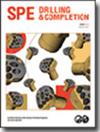Effects of Seepage on Gas Loss through Shale Desorption during Shale Core Removal
IF 1.2
4区 工程技术
Q3 ENGINEERING, PETROLEUM
引用次数: 0
Abstract
In the process of shale coring, the gas adsorption will increase the flow resistance of gas inside the core, which will inevitably affect the accuracy of shale gas loss. To clarify the underlying effects of seepage flow and related factors during shale desorption, we conducted an experimental study on the influence of methane on seepage resistance of fractured shale and matrix shale under different adsorption pressures. Changes in reservoir fluid and deformation resulting from CH4 saturation adsorption resulted in changes in shale permeability. This study investigated six adsorption durations (2, 4, 6, 12, 18, and 24 hours) under adsorption pressures of 5, 9, and 13 MPa in shale samples. During each cycle, different injection pressures (2 to 6 MPa) were applied, and seepage resistance of shale samples was measured by the transient method. The results showed that the permeation resistance of the sample decreased significantly after adsorption of CH4 reached saturation and decreased with increasing CH4 adsorption duration. Compared with matrix shale samples, fractured shale samples were shown to have more suitable pore microcracks and higher CH4 affinity. Therefore, fractured samples were found to have higher permeability resistance and higher adsorption capacity compared to matrix shale. The permeability flow of a sample had a negative exponential relationship with confining pressure, and stress sensitivity increased with increasing CH4 adsorption time. The model representing gas loss indicated a positive correlation between change in impermeability and the flow of escaped gas on the core surface. A significant reduction in the impermeability of the core will result in a significant reduction in shale gas loss.页岩取心过程中渗流对页岩解吸气体损失的影响
在页岩取芯过程中,气体吸附会增加岩心内部气体的流动阻力,这必然会影响页岩气损失的准确性。为了阐明页岩解吸过程中渗流的潜在影响及其相关因素,我们对不同吸附压力下甲烷对裂缝页岩和基质页岩渗流阻力的影响进行了实验研究。储层流体的变化和CH4饱和吸附引起的变形导致页岩渗透率的变化。本研究调查了六个吸附持续时间(2、4、6、12、18和24 小时),在5、9和13的吸附压力下 页岩样品中的MPa。在每个循环中,不同的喷射压力(2至6 MPa),并通过瞬态法测量页岩样品的渗透阻力。结果表明,样品的渗透阻力在CH4吸附达到饱和后显著降低,并随着CH4吸附时间的增加而降低。与基质页岩样品相比,裂隙页岩样品具有更合适的孔隙微裂纹和更高的CH4亲和力。因此,与基质页岩相比,压裂样品具有更高的渗透阻力和更高的吸附能力。样品的渗透率流量与围压呈负指数关系,应力敏感性随CH4吸附时间的增加而增加。表示气体损失的模型表明,不渗透性的变化与岩心表面逸出气体的流动之间呈正相关。岩心不渗透性的显著降低将导致页岩气损失的显著减少。
本文章由计算机程序翻译,如有差异,请以英文原文为准。
求助全文
约1分钟内获得全文
求助全文
来源期刊

SPE Drilling & Completion
工程技术-工程:石油
CiteScore
4.20
自引率
7.10%
发文量
29
审稿时长
6-12 weeks
期刊介绍:
Covers horizontal and directional drilling, drilling fluids, bit technology, sand control, perforating, cementing, well control, completions and drilling operations.
 求助内容:
求助内容: 应助结果提醒方式:
应助结果提醒方式:


